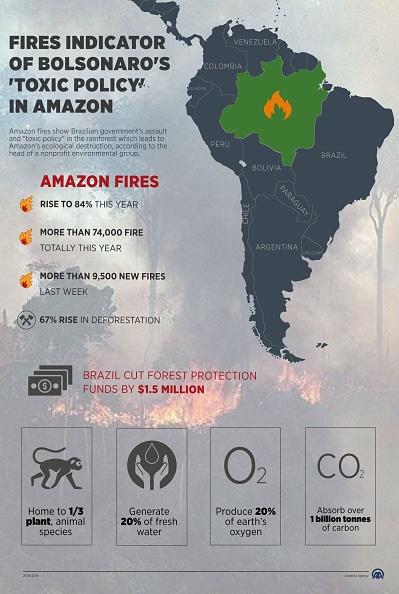Amazon fires a call to action

The lungs of the world are on fire, according to news reports of the burning of the Amazon rainforest in 2019.
This wanton destruction has actually been increasing over many years but has hit peak velocity in 2019, following the election of a Brazilian government that encourages economic development at any cost.
The fires are located mainly along the southern edge of the forest boundary where land is being cleared for farming. So far this year more than 80,000 such fires have been recorded in Brazil, with more than half in the Amazon region.
The fires are largely a consequence of the massive rate of land clearance in the Amazon, hitting a recent 10-year annual high of nearly 8,000 square kilometres.

Spurred on by government policy, farmers employ classic slash and burn agriculture, using machinery to clear the forest then burning the felled trees.
Much of the cleared land is not very fertile, so it is only used for productive agriculture for a few years before farmers need to clear yet more land.
This vicious cycle of poor agricultural practices is directly mirrored by the larger vicious cycle of global warming and climate change.
There is a vast amount of carbon stored in the forests and the fires release that carbon back into the atmosphere as the greenhouse gas carbon dioxide. Increasing carbon emissions contribute to global warming and climate change, which over the last 40 years has seen a warming, drying and stronger drought regime in the region. This changes forest conditions, making it easier to burn and causing the fires to burn with more intensity and for longer.
Native vegetation is very difficult to replace once it has been cleared, taking hundreds or even thousands of years to regenerate.
The potential loss of biodiversity and all the associated issues that go with that, including the astonishing pharmaceutical potential of plants that grow in such diverse and competitive environments, is a global tragedy.
There is action that governments, businesses, communities and individuals can take to conserve the Amazon rainforest.
This includes supporting The Nature Conservancy, and other like-minded organisations, which purchases and protects land with important conservation value.
DNA testing can now be used to confirm the origin of timber in the global supply chain. More countries could ban the logging that leads to wholesale land clearance and more could ban imports of illegally logged timber and prosecute those who transgress.
These Amazon fires serve as a beacon for the worst impacts we can have on the environment and our strongest focus should be on protecting the remaining native vegetation everywhere on the planet.
As with so many ills – prevention of the problem would be far more effective than trying to cure it.
Featured researcher
Professor Andrew Lowe
Director, Agriculture, Food and Wine
School of Biological Sciences
Faculty of Sciences
Featured researcher
Professor Robert Hill
Director - Environment Institute
Division of Research and Innovation
